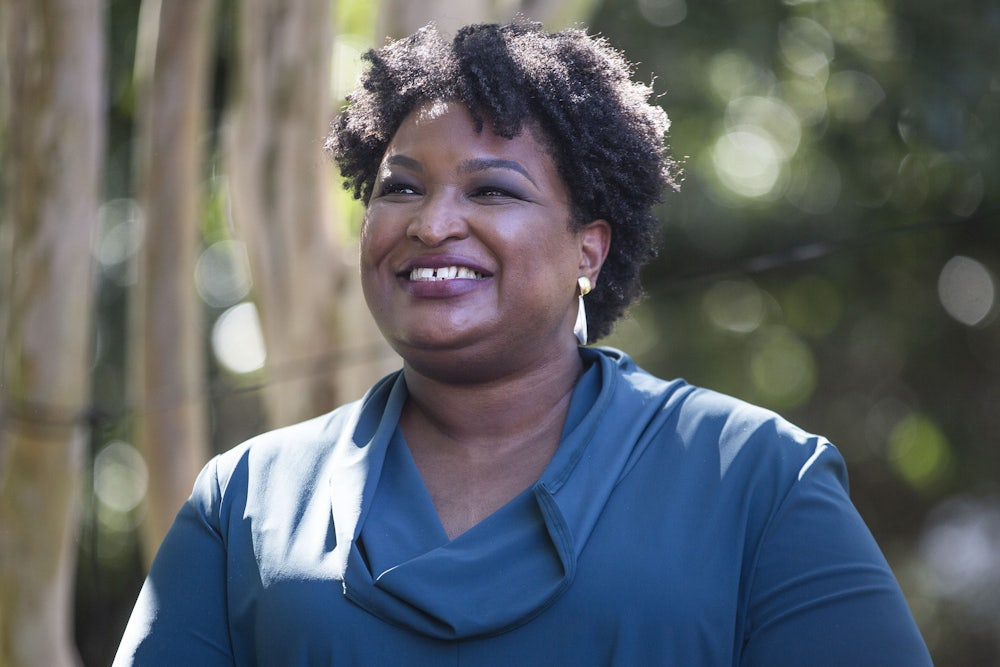In this year of intensely important midterm elections, probably no state in the nation will be more closely watched than Georgia. The Democrats’ most charismatic gubernatorial candidate will be seeking that office for the second time. The party’s junior incumbent senator, a surprise winner two years ago, faces a tough fight to hold onto his seat. The Republican side will feature two rough-and-tumble primaries between non-Trump and (very) pro-Trump candidates.
Ask any Republican or Democratic operative, and they have the same prediction: All this action means that Georgia will see turnout that will make jaws drop. It’s just not clear, though, which party will benefit from that high turnout.
It’s rare that a state has multiple statewide races with outsize national implications. Democrats want the governor’s race to result in the state’s—and the country’s—first Black woman governor in Stacey Abrams. Republicans meanwhile are divided over whether to renominate Brian Kemp, a governor reviled by Donald Trump for refusing to do Trump’s bidding after the 2020 vote, or pick the former president’s preferred alternative, former Senator David Perdue, who’s been a total Trump lackey. And the state’s usually sleepy secretary of state race has a primary this time around that Trump has helped turn into a referendum on his control of the Republican Party: The former president wants to oust Secretary of State Brad Raffensperger and replace him with the Trump-endorsed Congressman Jody Hice.
“You have marquee candidates. You have multiple races between the governor’s race and the Senate race that are top-tier national attention, national stakes. You have the bases of both parties fired up,” said Tom Bonier, a Democratic strategist who runs a political data firm.
That means, in all likelihood, sky-high turnout. The traditional thinking in the political world for years has been that high turnout will benefit Democrats, because it is assumed that most voting-age nonvoters lean Democratic—younger, poorer, disproportionately people of color. But both Republican and Democratic strategists aren’t sure that will be the case in Georgia this time.
“I think we’ve learned in recent elections—and Virginia’s as good an example as any—high turnout by itself doesn’t necessarily help Democrats,” said Democratic strategist Eli Kaplan, whose firm has extensive experience helping Democrats win in the South. “In 2020, you had this dynamic where turnout was the highest we’ve ever seen it in the modern era. In a midterm like this, the question is, when you look at the people who showed up in 2020, which side can get a higher percentage of them to show up again?”
Participation in Georgia has been on the rise in the last few years. By 2019, the state had seen 95 percent of eligible voters registered to vote, something that Abrams has made a hallmark of her career. In 2020, almost five million people voted for President Biden or Donald Trump. By comparison, in 2016 just short of four million people voted for Trump or Hillary Clinton. In 2018, almost four million people voted for either Kemp or Abrams in the gubernatorial election. And in the January 2021 runoff election that Senator Raphael Warnock won, almost 4.5 million people voted for either Warnock or then-Senator Kelly Loeffler—a huge number for a non-November vote.
Recent elections have also shown that new registrants are sensitive to the races available to vote in. A dip of about 750,000 Republican voters who voted in Georgia in the 2020 presidential race but didn’t show up for the January runoff in the Senate race helped propel Warnock to his narrow, two-percentage-point victory. Even with rising participants in the state’s elections, candidates, as the saying goes, matter a lot. In the case of the January runoff, some of those voters were turned off by Trump’s loss in the presidential race and his subsequent bullying of Raffensperger (“I just want to find 11,780 votes”). The 2020 primary was also divisive for Republicans, as Loeffler had to run against Warnock but watch her right flank from a challenge by Trump ally and House member Doug Collins.
The Senate elections in Georgia decided control of the chamber, and quite dramatically so—it was around 3:30 on the afternoon of January 6, 2021, while the Capitol was being overrun, that Jon Ossoff was declared the winner in the other Georgia race, handing Senate control to the Democrats (Ossoff is the senior senator because he was elected to a longer term). National personalities all played a factor in the past few cycles. Primary challenges, voter fatigue, and national consequences: Those ingredients are all very much here for the 2022 midterms. Abrams is a national Democratic star. Trump has multiple obsessions with the outcome of the elections in Georgia and an ongoing slice of the electorate who will follow whatever endorsement he makes. But that’s only a fraction of the Republican electorate in the state, said Eric Tannenblatt, a chief of staff to former GOP Governor Sonny Perdue.
“I think if given a choice between Joe Biden and Donald Trump, people would pick Donald Trump here, but I think of the Republican primary vote, I think there’s probably 20 percent who are just hard-core and won’t question it,” Tannenblatt said. If just 20 percent of Georgia Republicans are unswayable Trump Republicans, then that leaves a lot of room for the likes of Kemp and Raffensperger to win reelection.
For years now, Democrats have viewed rising turnout as the missing piece to winning in Republican strongholds. But it’s unclear whether increased turnout will occur because of an energized Republican electorate or a new set of previously untapped Democratic voters. That’s a shift from past election cycles in Georgia, Bonier noted.
“Georgia has also become a state where, for either side, you kind of have to do it all. You have to get your base out, but you also have to be able to persuade,” Bonier said. “Republicans for the longest time could win just by getting their base out. And I think 2020 has to have been the wake-up call for [Republicans] that they just can’t do that.”
The outcomes of these statewide elections in Georgia will have national implications not just in 2022 but also for the 2024 presidential race. It’s possible that whoever wins this year’s Senate race will be the deciding vote, again, for control of the chamber. And whoever sits in the governor’s mansion and secretary of state’s office will play a key role in overseeing the 2024 elections, when we may see a Biden versus Trump rematch. Georgia’s 16 electoral votes were a big factor in Biden’s win in 2020, when he carried the state by just around 12,000 votes.
Democrats should remember that if Georgia does buck the trends of this cycle and has overwhelming turnout for Democrats, it will be because of their gubernatorial candidate. Abrams, for years, has maintained that Georgia could be a blue state or at least a more competitive state by registering and activating ignored and unrecognized voters. She knew then that her prospects for statewide office depended on that argument, and now the fortunes of her and Warnock also depend on how well Democrats have worked to activate their voters.










